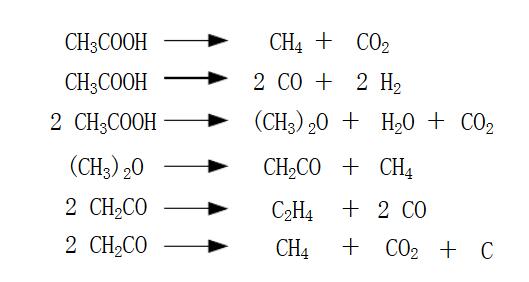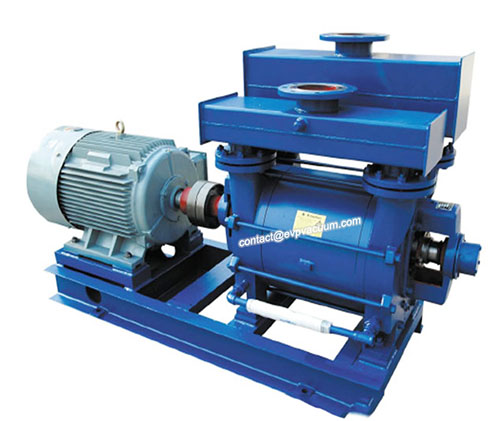Vacuum pump for acetic anhydride production process
Acetic acid is used in the production of acetic anhydride. In the presence of high temperature, negative pressure and catalyst triethyl phosphate, the acetic acid vapor is cracked in the cracking pipe to produce vinyl ketone and water. After condensation and cooling separation, vinyl ketone is absorbed by acetic acid to generate crude acetic anhydride, which is then purified by distillation to produce finished acetic anhydride. The dilute acetic acid produced in the production process is recovered by the ethyl acetate extraction method, and the recovered acetic acid is used for cracking.
(1) Cracking process
① The triethyl phosphate is sucked into the intermediate tank by vacuum for standby; the acetic acid is pumped into the acetic acid high-level tank by the acetic acid storage tank.
② The acetic acid enters the acetic acid preheater from the high-level tank for preheating, the preheating temperature reaches 80 ℃, the preheated acetic acid enters the acetic acid evaporator, the temperature of the evaporator reaches above 120 ℃, a small amount of steam (about 4% of the acetic acid content) is added at the same time, the acetic acid steam and water steam are mixed in the evaporator and then go to the cracking furnace, and enter the cracking process after entering the cracking process and mixing with triethyl phosphate sent by the metering vacuum pump The first section of the furnace (electric heating) is preheated to 400-600 ℃, and then enters the second section. The reaction temperature of the second section is 690-755 ℃, and the cracking furnace pressure is – 0.025mpa.
③ After cracking, the reactant is mixed with ammonia (polymerization inhibitor to prevent the polymerization of vinyl ketone to form diethylene ketone, accounting for about 0.05% of the acetic acid content) at the outlet of the secondary pipe. The mixture enters the condensing cooler, the upper section of the condensing cooler is cooled by water, and the cooled dilute acetic acid is directly entered into the dilute acetic acid discharge tank, the lower section is cooled by frozen brine, the cooled material enters the gas-liquid separator, and the uncondensed mixture (vinyl ketone and waste gas, waste gas mainly contains carbon dioxide, hydrogen, methane, carbon monoxide, etc.) enters the absorption process. The condensed dilute acetic acid enters the intermediate tank of dilute acetic acid from the gas-liquid separator, and the dilute acetic acid is recovered in the deacetylation recovery process.
Reaction equation:

Side effects:

(2) Vinyl ketone absorption process
① The ketene and waste gas from the gas-liquid separator of cracking process enter the bottom of the first absorption tower, while the crude acetic anhydride enters the top of the first absorption tower from the crude acetic anhydride circulating tank for liquid gas absorption, and the liquid returns to the crude acetic anhydride circulating tank, and the crude acetic anhydride is pumped into the distillation process.
② The unabsorbed mixture in the first absorption tower escapes from the top to the bottom of the second absorption tower. At the same time, the acetic acid overflowing from the acetic acid high-level tank enters the top of the second absorption tower through the second circulating liquid vacuum pump, and the absorbed liquid exits from the bottom. One part is pumped into the top of the second absorption tower by the second circulating liquid vacuum pump (for circulating absorption), the other part is pumped into the first absorption tower by the first circulating liquid vacuum pump for circulating liquid; the unabsorbed gas enters the washing tower.
③ The mixture escaping from the top of the second absorption tower enters the bottom of the washing tower, while the dilute acetic acid (water for initial start-up) enters the top of the washing tower through the circulating liquid pump. The gas and liquid are absorbed in the absorption tower, and the liquid flows back to the circulating washing liquid tank from the bottom. When the circulating liquid reaches a certain concentration, the circulating washing liquid is pumped to the dilute acetic acid recovery process for recovery, and the unabsorbed waste gas enters the washing tower.
④ The waste gas from the washing tower enters the bottom of the tail gas absorption tower, and at the same time, it is fed into the process water from the top. The waste gas is absorbed in the tower with the process water. The liquid enters the water sealed tank and is discharged outside. The unabsorbed waste gas is pumped out to the gas-liquid separation tank with the liquid ring vacuum pump and then discharged. The waste water in the water seal tank and separation tank enters the waste water treatment center for treatment.
Reaction equation:

(3) Distillation process
The crude acetic anhydride from the crude acetic anhydride absorption process enters the evaporator for gasification (130 ℃, – 0.03mpa). The gasified crude acetic anhydride enters the middle of the acetic acid distillation tower from the gas phase at the top of the evaporator, and is separated in the tower. The acetic acid steam is condensed by the reflux condenser, and the liquid is refluxed. The uncondensed steam enters the condenser, and the condensation temperature is guaranteed to be between 20-40 ℃. The condensed liquid is acetic acid product Enter the acetic acid storage tank in the tank farm, regularly discharge the acid slag from the evaporator, and conduct the outsourcing treatment. The bottom liquid of the tower enters the reboiler of the acetic anhydride distillation tower, after heating (107-123 ℃, – 0.03mpa), the acetic anhydride steam enters the distillation tower for separation, the separated acetic anhydride steam condenses and cools through the reflux condenser, the liquid returns, the uncondensed steam enters the condenser cooler, the condensation temperature is normal temperature, the condensed acetic anhydride enters the acetic anhydride receiving tank, and enters the acetic anhydride storage tank in the tank farm after passing the test The unqualified product enters the crude acetic anhydride storage tank for re distillation.
(4) Recovery process of dilute acetic acid
① Dilute acetic acid from the condensation of cracking process, washing liquid from absorption process and residual liquid of ester water distillation tower enter the dilute acetic acid tank, and add ester water or fresh tap water, and configure it to a certain concentration. After the preparation, the material is discharged from the bottom, pumped to the top of the extraction tower, and the ethyl acetate from the intermediate tank of ethyl acetate is pumped to the bottom of the extraction tower, two strands The liquid is extracted in the extraction tower. The upper layer is the ester acid layer, and the material is discharged from the top of the extraction tower to the middle and upper part of the azeotrope tower for distillation. The lower layer is the ester water layer, which enters the ester water tank.
② The ester acid liquid is gasified (reboiler temperature 130 ℃, atmospheric pressure) and separated in the azeotrope tower. The azeotrope of ethyl acetate and water passes through the condenser on the top of the tower, and the liquid condenses and flows back. The uncondensed steam condenses through the condenser and then enters the layerer. The upper layer is the layer of ethyl acetate, which overflows to the intermediate tank of ethyl acetate for recycling. The lower layer is sent to the ester water tank, and part is used for acid distribution to the dilute acetic acid tank, Some of them are distilled in ester water distillation tower to recover ethyl acetate and dilute acetic acid. The acetic acid at the bottom of the azeotropic tower is condensed by the acetic acid condenser and then put into the acetic acid intermediate tank for use.
③ The ester water from the ester water storage tank enters the ester water distillation tower after preheating by the preheater, with the preheating temperature of 60 ℃. After direct heat exchange with steam in the distillation tower, it is separated in the tower. The low boiling point azeotrope flows through the tower head condenser, and the liquid returns to the tower. The uncondensed azeotropic steam enters the ester water condenser, and then enters the layerer to recover ethyl acetate. The bottom steam and ester water are pre heated The ester water in the heat exchanger is condensed after heat exchange. Part of the condensed liquid enters the dilute acetic acid storage tank for acid distribution and part of it enters the waste water station.


